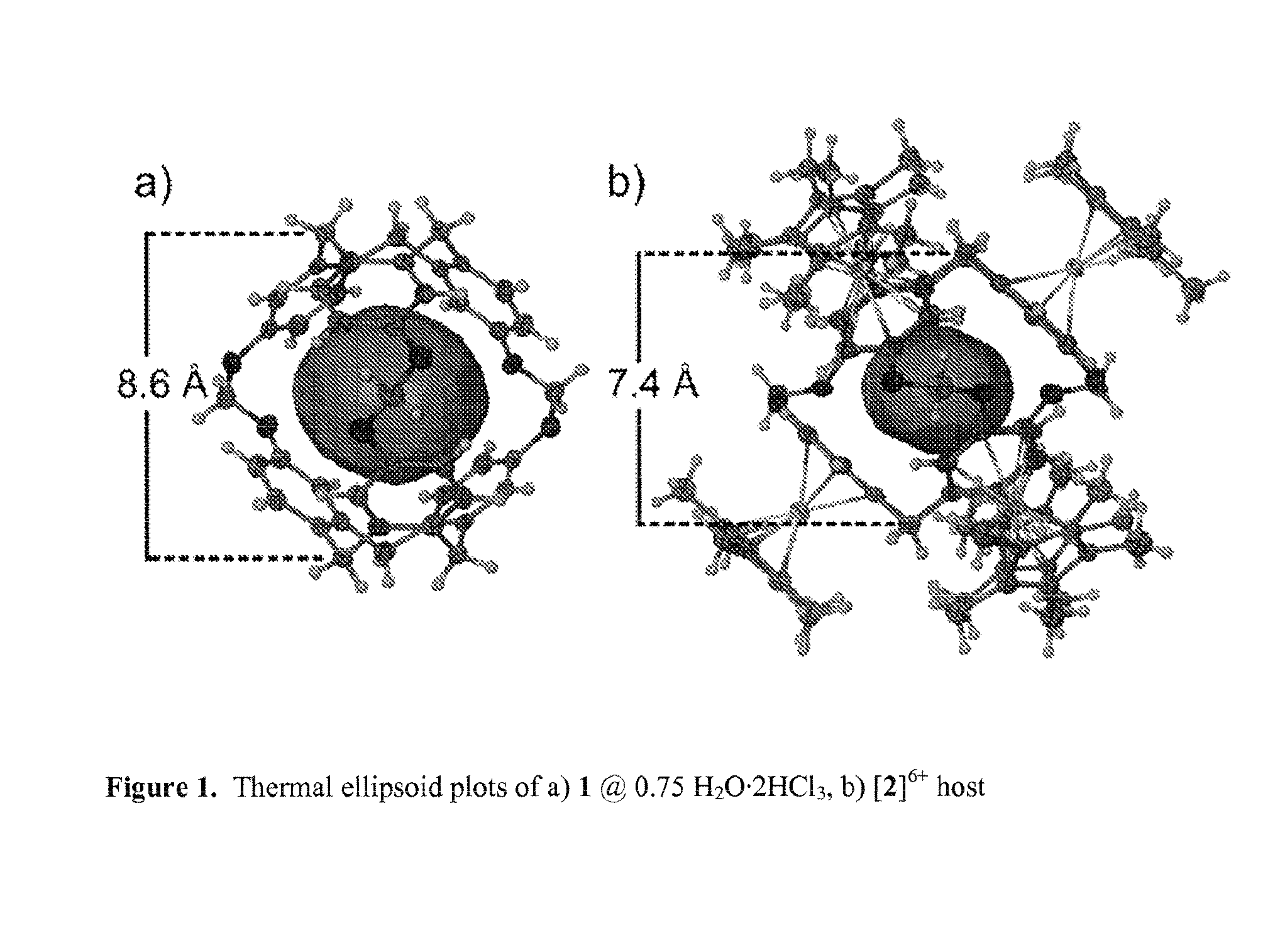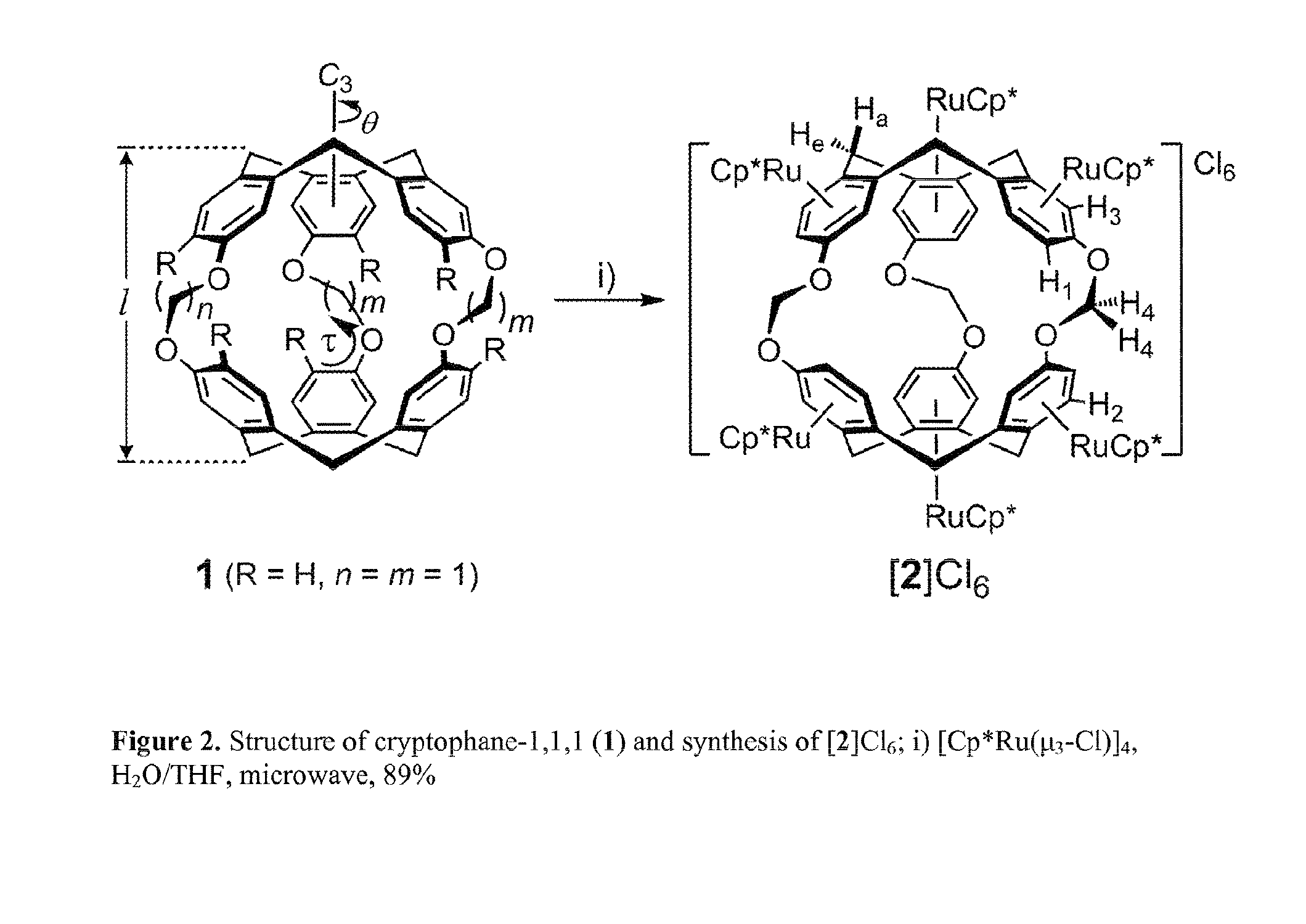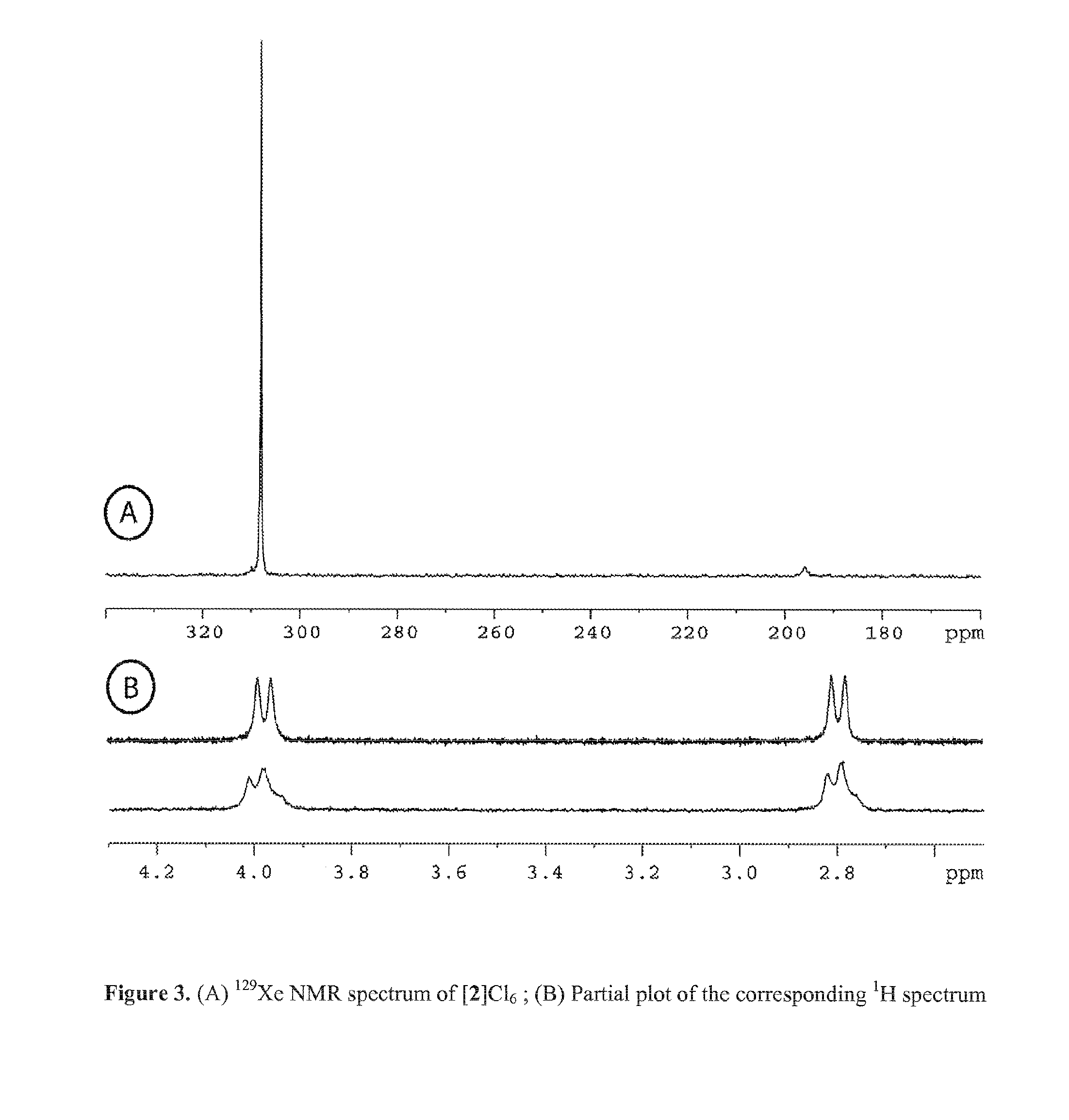Cryptophane derivatives and methods of use thereof
a technology of cryptophane and derivatives, applied in the field of cryptophane derivatives, can solve the problems of poor water solubility of hosts, application of xenon-based biosensors, and insufficient molecular imaging
- Summary
- Abstract
- Description
- Claims
- Application Information
AI Technical Summary
Benefits of technology
Problems solved by technology
Method used
Image
Examples
example 1
Synthesis of (±)-[(Cp*Ru)6(1)]Cl6((±)-[2]Cl6) and (±)-[Cp*Ru)6(1)][CF3SO3]6((±)-[2][CF3SO3]6)
[0190]
[0191]Under an N2 atmosphere, (±)-cryptophane-111 (1) (30 mg, 0.045 mmol) was dissolved in THF (3 mL) in a 10 mL microwave reaction vessel. [Cp*Ru(μ3-Cl)]4 (102 mg, 0.094mmol, 8.4 eq. Ru) was added, followed by degassed water (5 mL). The vessel was sealed and reacted at 130° C. for 30 minutes under microwave irradiation to give a red solution. The solvent of reaction mixture was removed under vacuum.
[0192]The solid was added to a silica column and chromatographed using methanol, saturated aqueous NH4HCO3, and water (4:4.5:0.5, Rf=0.11). The solvent was removed under vacuum at 55° C. To remove excess NH4HCO3, additions of methanol / water were added and removed under vacuum at 55° C. stepwise until evolution of NH3 ceased. The solid was dissolved in H2O / methanol and passed over Amberlite-IRA 410 Cl beads (chloride ion exchange beads). The solvent was removed under vacuum at 50° C. and the...
example 2
Synthesis of (±)-[((η5-C5Me5)Ru)6(1)]Cl6([Ru6(1)]Cl6), C105H126Ru6O6Cl6, MW=2303.26 g mol−1; [Ru5(1)]Cl5, C95H111Ru5O6Cl5, MW=2031.51 g mol−1; and [Ru4 (1)]Cl4, C85H96Ru4O6Cl4, MW=1759.76 g mol−1; and [Ru3(1)]Cl3, C75H81Ru3O6Cl3, MW=1427.96 g mol−1 regioisomeric mixtures:
[0194]Under an N2 atmosphere, cryptophane-111 (1) (59 mg, 0.088 mmol) was dissolved in THF (4 mL) in a 10 mL microwave vessel. [Cp*Ru(η3-Cl)]4 (104.9 mg, 0.39 mmol, 4.4 eq.) was added, followed by degassed water (4 mL). The vessel was sealed and reacted at 130° C. for 30 minutes under microwave irradiation to give a transparent, brown solution. The solvent was removed by vacuum.
[0195]The resulting solid was dissolved in methanol, spotted onto a silica TLC plate, and chromatographed using a mobile phase of methanol and saturated aqueous NH4HCO3 (3:1). Following development, four fractions corresponding to [Ru61]Cl6, [Ru51]Cl5, [Ru41]Cl4, and [Ru31]Cl3 were observed on the TLC plate (Rf of [Ru61]Cl651]Cl541]Cl431]Cl3)...
example 3
Synthesis of (±)-[((η5-C5Me5)Ru)3(1)]Cl3 ([Ru3(1)]Cl3), C75H81Ru3O6Cl3, MW=1427.96 g mol−1 [Ru2(1)]Cl2, C65H66Ru2O6Cl2, MW=1216.26 g mol−1; and [Ru1(1)]Cl1, C55H51Ru1O6Cl1, MW=944.51 g mol−1 regioisomeric mixtures:
[0196]Under an N2 atmosphere, cryptophane-111 (1) (8 mg, 0.012 mmol) was dissolved in THF (4 mL) in a 10 mL microwave vessel. [Cp*Ru(η3-Cl)]4 (4 mg, 0.015 mmol, 1.25 eq.) was added, followed by degassed water (4 mL). The vessel was sealed and reacted at 130° C. for 30 minutes under microwave irradiation to give a transparent, colorless solution. The solvent was removed by vacuum. The resulting solid was dissolved in methanol, spotted onto a silica TLC plate, and chromatographed using a mobile phase of methanol, saturated aqueous NH4HCO3, and water (5:1:2). Following development, three fractions corresponding to [Ru3(1)]Cl3, [Ru2(1)]Cl2, and [Ru1(1)]Cl1 were observed on the TLC plate (Rf of [Ru3(1)]Cl32(1)]Cl21(1)]Cl1) under UV irradiation. The silica containing each fracti...
PUM
| Property | Measurement | Unit |
|---|---|---|
| Temperature | aaaaa | aaaaa |
| Affinity | aaaaa | aaaaa |
| Chemical shift | aaaaa | aaaaa |
Abstract
Description
Claims
Application Information
 Login to View More
Login to View More - R&D
- Intellectual Property
- Life Sciences
- Materials
- Tech Scout
- Unparalleled Data Quality
- Higher Quality Content
- 60% Fewer Hallucinations
Browse by: Latest US Patents, China's latest patents, Technical Efficacy Thesaurus, Application Domain, Technology Topic, Popular Technical Reports.
© 2025 PatSnap. All rights reserved.Legal|Privacy policy|Modern Slavery Act Transparency Statement|Sitemap|About US| Contact US: help@patsnap.com



